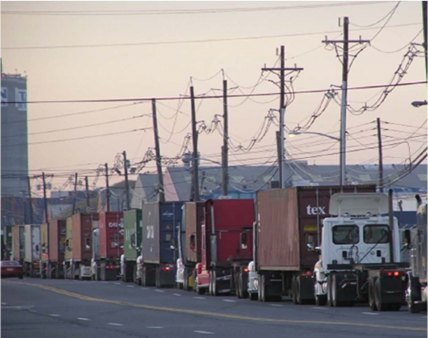Port Gate Management Strategies Improve Air Quality and Efficiency at Ports
On this page:
- Overview
- Types of Strategies
- Key Advantages of Gate Management
- Strategy Implementation Considerations
- Cost and Savings Components
Overview
Long truck queues at terminal gates can contribute significantly to emissions, noise, and traffic congestion in and around ports. Gate management strategies reduce idle emissions at ports by redistributing truck arrivals away from peak periods and lowering average wait times. Well-designed programs can also improve coordination of freight transfer activities, decreasing truck turn times and improving overall terminal efficiency.
Various strategies have been implemented and continue to evolve at many ports including Los Angeles, Long Beach, New York/New Jersey, Baltimore, Savannah, New Orleans, and Oakland. Gate management strategies can be adopted by ports of any size. Larger ports with more complex operations and terminal operating system (TOS) frameworks that control the movement and storage of cargo in and around container terminals may realize the most value from automated gate technologies.
For a detailed discussion go to the fact sheet: Port Operational Strategies: Gate Management(PDF) (March 2021, EPA-420-F-21-006).
Types of Strategies

The main types of gate management strategies include:
- Truck appointment systems: Truck drivers use electronic systems to reserve specific timeslots in advance, distributing gate arrivals across all hours of operation.
- Extended hours of operation: Extended gate hours reduce peak period activity, enabling drayage operators to schedule off-peak arrivals and avoid road congestion, long queues, and pickup/drop-off delays.
- Automated gate systems: A range of automating technologies can improve communication between the terminal gate and freight yard. Typically integrated within a port’s terminal operating system (TOS), these systems automatically identify trucks and containers and facilitate access, loading, and unloading for drayage trucks entering the terminal gate. Automated gate system technologies include:
- Bar code reader systems, which use bar codes and scanners to identify and track containers.
- Optical character recognition (OCR) systems, which use cameras and scanners to identify containers, chassis information, and truck license plates upon entry and exit.
- Radio frequency identification (RFID) systems, which use tags attached to containers and trucks that transmit information to RFID readers.
- Real-time location systems (RTLS), which use wireless tags on trucks and containers to track their position relative to fixed receiving points.
- Closed circuit television (CCTV), which uses strategically positioned cameras to assess real-time gate and yard conditions.
- Differential Global Positioning System (DGPS), which uses satellite-based navigation to transmit truck and container coordinates. Requires DGPS receivers on target units.
Key Advantages of Gate Management
- By reducing vehicle queues and idling, minimizing gate traffic variability, and decreasing local roadway congestion, gate management strategies reduce peak period and total emissions, improving the health of port workers and nearby communities (see emission reductions example calculation).
- When combined with port management information systems (PMIS) [link to PMIS landing page] that manage processes for ship arrival and departure, appointments and automated gate systems can help efficiently coordinate trucks with container movement, storage, and pre-staging.
- Extended gate hours coupled with improved throughput can expand terminal capacity, shifting truck activity away from peak periods and allowing ports to serve more and/or larger vessels.
Strategy Implementation Considerations
- Effective truck appointment systems require adherence to scheduled appointments by all parties, including truck, terminal, and vessel operators.
- Difficulties may arise from weather-related vessel delays and truck delays due to traffic congestion, although dedicated lanes and preferential access for appointments can minimize these impacts.
- If implemented as a stand-alone measure, gate appointments may simply move truck delays from one time and place to another. However, with advanced pre-staging of containers, these systems can ensure efficient and timely truck turns.
- Extending hours can encounter challenges such as obtaining additional labor to staff terminals and gates, and contract restrictions on off-peak labor.
- Extended hours should be coordinated with off-port destination facilities to minimize overall truck trip idling.
- Extending hours may also cause concerns due to increased traffic in surrounding communities during off-peak hours.
- Extended hours may be restricted by noise and other local ordinances.
- Automated gate systems must be compatible with each port’s TOS framework, accounting for technology limitations through proper system design and integration.
Costs and Savings Components
- Upfront costs can include labor associated with system installation; equipment such as cameras, scanners, tags, and receivers; and software for scheduling and mobile apps.
- Operational costs include equipment maintenance, software updates, and increased labor and utilities for extended hours.
- Cost savings may result from reduced fuel consumption from less idling, and reduced labor costs and demurrage fees from quicker drayage turn times.
